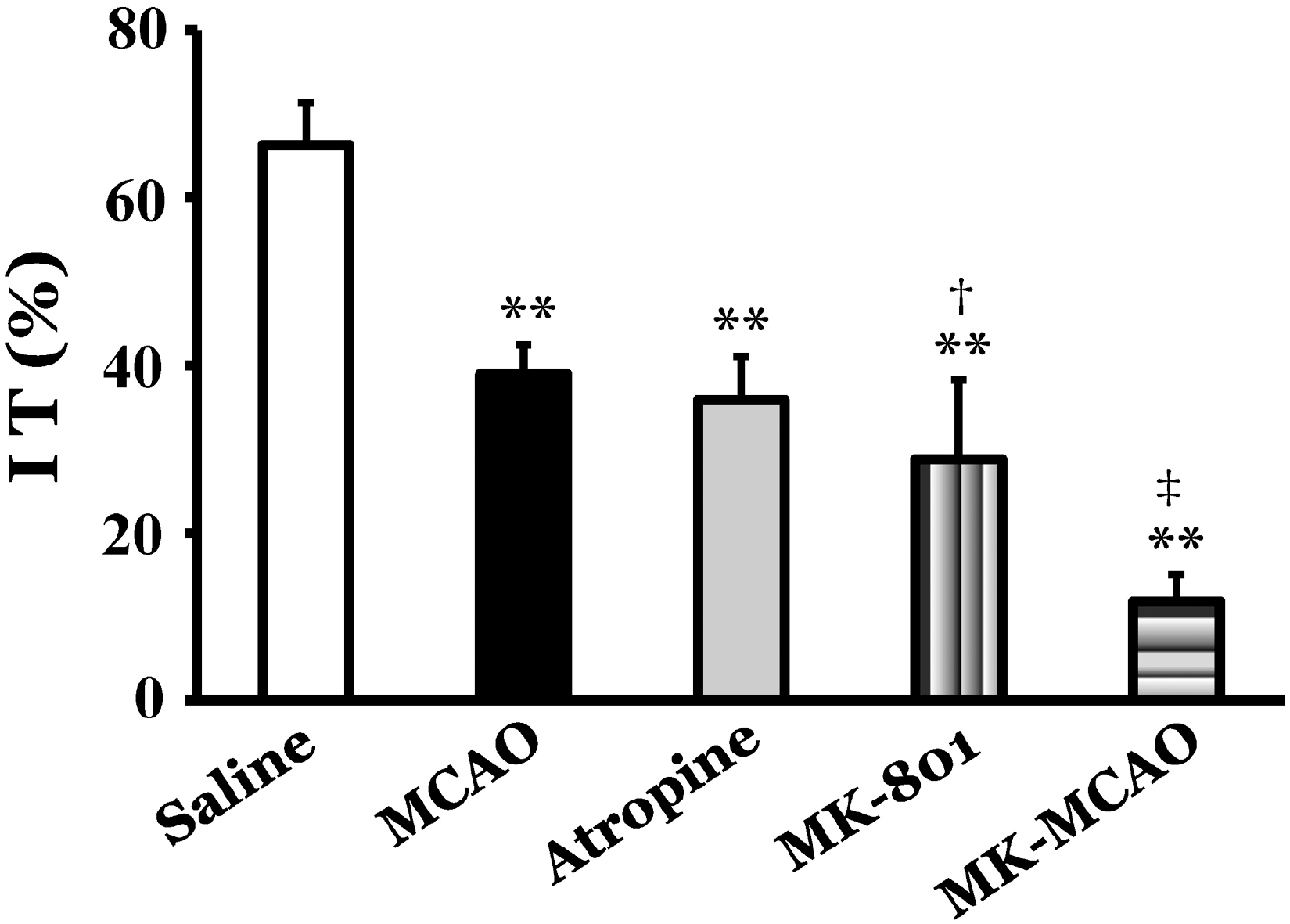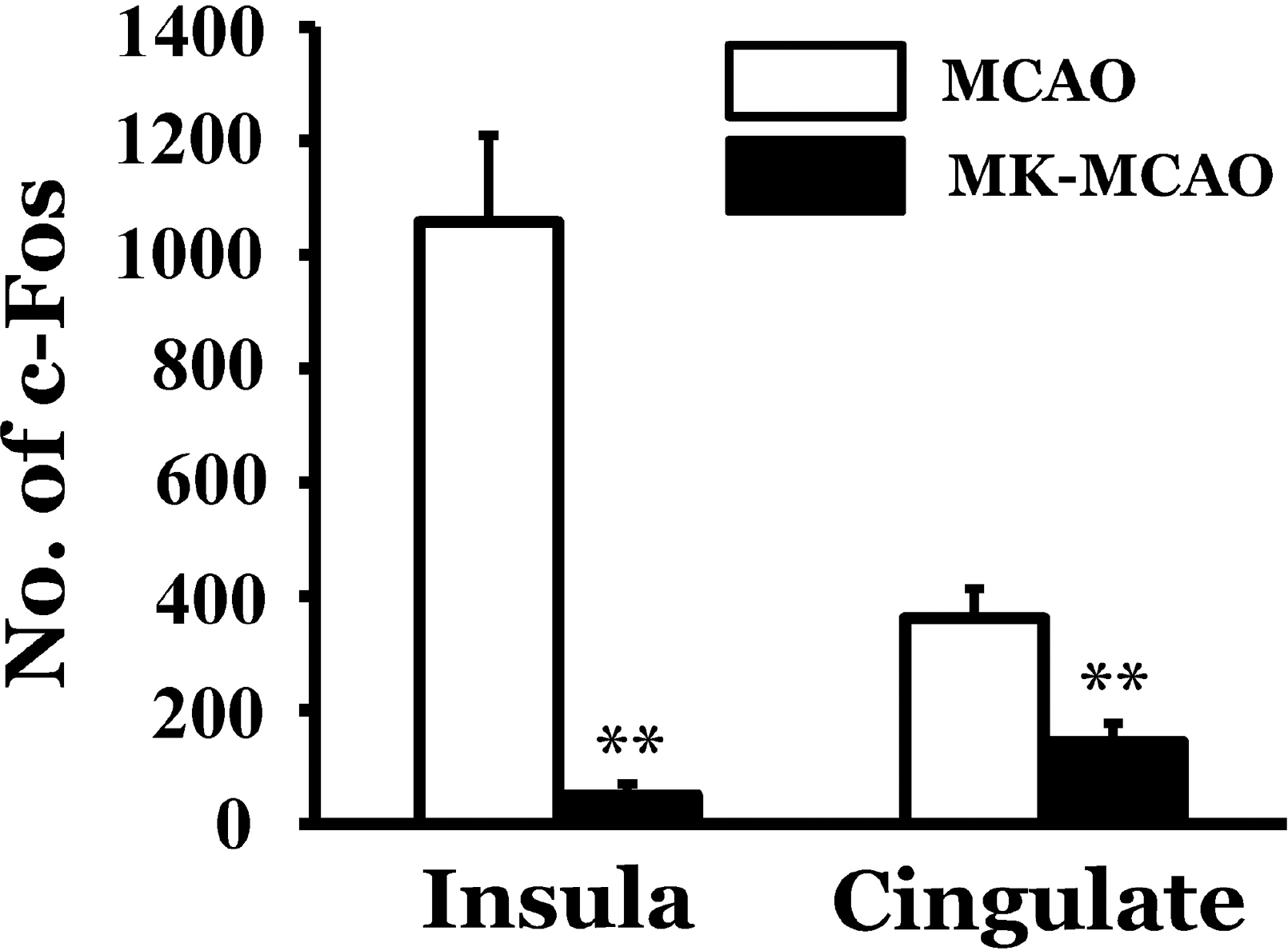Abstract
This study was performed to investigate the role of glutamate neurotransmitter system on gastrointestinal motility in a middle cerebral artery occlusion (MCAO) model of rats. The right middle cerebral artery was occluded by surgical operation, and intestinal transit and geometric center as a parameter of gastrointestinal motility and expression of c-Fos protein in the insular cortex and cingulate cortex were measured at 2 and 12 h after MCAO. Intestinal transit was 66.3±7.5% and 62.3±5.7% 2 and 12 h after sham operation, respectively, and MCAO significantly decreased intestinal transit to 39.0±3.5% and 47.0±5.1% at 2 and 12 h after the occlusion, respectively (p<0.01). The geometric center was 5.6±0.4 and 5.2±0.9 at 2 and 12 h after sham operation, respectively, and MCAO significantly decreased geometric center to 2.9±0.8 and 3.0±0.3 at 2 and 12 h after the occlusion, respectively (p<0.01). In control animals, injection of atropine decreased intestinal transit to 35.9±5.2%, and injection of glutamate NMDA receptor antagonist, MK-801, decreased intestinal transit to 28.8±9.5%. Pretreatment with MK-801, a glutamate NMDA receptor antagonist, in the MCAO group decreased intestinal transit to 11.8±3.2%, which was significantly decreased compared to MCAO group (p<0.01). MCAO markedly increased the expression of c-Fos protein in the insular cortex and cingulate cortex ipsilateral to the occlusion 2 h after MCAO, and pretreatment with MK-801 produced marked reduction of c-Fos protein expression compared to MCAO group (p<0.01). These results suggest that modulation of gastrointestinal motility after MCAO might be partially mediated through a glutamate NMDA receptor system.
Go to : 
References
1. Cheung RT, Hachinski V. The insula and cerebrogenic sudden death. Arch Neurol. 2000; 57:1685–1688.

2. Cheung RT, Hachinski VC, Cechetto DF. Cardiovascular response to stress after middle cerebral artery occlusion in rats. Brain Res. 1997; 747:81–88.

3. Dutsch M, Burger M, Dorfler C, Schwab S, Hilz MJ. Cardiovascular autonomic function in poststroke patients. Neurology. 2007; 69:2249–2255.

4. Harari D, Norton C, Lockwood L, Swift C. Treatment of constipation and fecal incontinence in stroke patients: Randomized controlled trial. Stroke. 2004; 35:2549–2555.
5. Bracci F, Badiali D, Pezzotti P, Scivoletto G, Fuoco U, Di Lucente L, Petrelli A, Corazziari E. Chronic constipation in hemiplegic patients. World J Gastroenterol. 2007; 13:3967–3972.
6. Liu MT, Rothstein JD, Gershon MD, Kirchgessner AL. Glutamatergic enteric neurons. J Neurosci. 1997; 17:4764–4784.

7. Bagaev V, Aleksandrov V. Visceral-related area in the rat insular cortex. Auton Neurosci. 2006; 125:16–21.

8. Aleksandrov VG, Bagaev VA, Nozdrachev AD, Panteleev SS. Identification of gastric related neurons in the rat insular cortex. Neurosci Lett. 1996; 216:5–8.
9. Bush G, Luu P, Posner MI. Cognitive and emotional influences in anterior cingulated cortex. Trends Cogn Sci. 2000; 4:215–222.
10. Saito I, Segawa H, Shiokawa Y, Taniguchi M, Tsutsumi K. Middle cerebral artery occlusion: correlation of computed tomography and angiography with clinical outcome. Stroke. 1987; 18:863–868.

11. Stern RM, Koch KL, Stewart WR, Lindblad IM. Spectral analysis of tachygastria recorded during motion sickness. Gastroenterology. 1987; 92:92–97.

12. Cabezos PA, Vera G, Castillo M, Fernandez-Pujol R, Martin MI, Abalo R. Radiological study of gastrointestinal motor activity after acute cisplatin in the rat. Temporal relationship with pica. Auton Neurosci. 2008; 141:54–65.

13. Miller MS, Galligan JJ, Burks TF. Accurate measurement of intestinal transit in the rat. J Pharmacol Methods. 1981; 6:211–217.

14. Puig N, Davalos A, Adan J, Piulats J, Martinez JM, Castillo J. Serum amino acid levels after permanent middle cerebral artery occlusion in the rat. Cerebrovasc Dis. 2000; 10:449–454.

15. Laing RJ, Jakubowski J, Laing RW. Middle cerebral artery occlusion without craniectomy in rats. Which method works best? Stroke. 1993; 24:294–298.

16. Lee JH, Ameer AN, Choi MA, Lee MY, Kim MS, Park BR. Recovery of vestibulogastrointestinal symptoms during vestibular compensation after unilateral labyrinthectomy in rats. Otol & Neurotol. 2010; 31:241–249.

17. Kim MS, Jin BK, Chun SW, Lee MY, Lee SH, Kim JH, Park BR. Effect of MK801 on cfos-like protein expression in the medial vestibular nucleus at early stage of vestibular compensation in uvulonodullectomized rats. Neurosci Lett. 1997; 231:147–150.

18. Colivicchi F, Bassi A, Santini M, Caltagirone C. Cardiac autonomic derangement and arrhythmias in right-sided stroke with insular involvement. Stroke. 2004; 35:2094–2098.

19. Mesulam MM, Mufson EJ. Insula of the old world monkey. III: Efferent cortical output and comments on function. J Comp Neurol. 1982; 212:38–52.

20. Schneider RJ, Friedman DP, Mishkin M. A modality-specific somatosensory area within the insula of the rhesus monkey. Brain Res. 1993; 621:16–120.

21. Yasui Y, Breder CD, Saper CB, Cechetto DF. Autonomic responses and efferent pathways from the insular cortex in the rat. J Comp Neurol. 1991; 303:355–374.

22. Korpelainen JT, Sotaniemi KA, Myllyla VV. Autonomic nervous system disorders in stroke. Clin Auton Res. 1999; 9:325–333.

23. Collaco-Moraes Y, Aspey BS, de Belleroche JS, Harrison MJ. Focal ischemia causes an extensive induction of immediate early genes that are sensitive to mk-801. Stroke. 1994; 25:1855–1860.
24. Choi D. Excitotoxicity, apoptosis, and ischemic stroke. J Biochem Mol Biol. 2001; 34:8–14.
Go to : 
 | Fig. 1.Changes in intestinal motility 2 and 12 h after MCAO. Sham, the common carotid artery, internal carotid artery and external carotid artery in the right side were exposed through a midline incision of the neck and the incision of the skin was sutured; MCAO, middle cerebral artery occlusion; IT, intestinal transit; GC, geometric center; Post-op, time after MCAO. The number of animals was 7 in each session of each group. Values are mean±SD. ∗∗Significant differences between Sham and MCAO (∗∗p<0.01). |
 | Fig. 2.Effect of MK-801 on intestinal motility after MCAO. Intestinal transit was measured 2 h after injection or surgery. Saline, intraperitoneal injection of sterile saline solution (1.0 ml/kg) in control animals; MCAO, middle cerebral artery occlusion; Atropine, intraperitoneal injection of atropine sulfate in control animals; MK-801, intraperitoneal injection of MK-801 in control animals; MK-MCAO, pretreatment with MK-801 in MCAO. The number of animals was 5 in each group, except MCAO group (n=7, data from Fig. 1). Values are mean±SD. ∗∗Significant differences from Saline (∗∗p<0.01). †Significant differences from MCAO (†p<0.05, ‡p<0.01). |
 | Fig. 3.Effect of MK-801 on expression of c-Fos protein in the insular cortex and cingulate cortex ipsilateral to the occlusion 2 h after MCAO. MCAO, middle cerebral artery occlusion; MK-MCAO, pretreatment with MK-801 in MCAO. The number of animals was 5 in each group. Values are mean±SD. ∗∗Significant differences between MCAO and MK-MCAO (∗∗p<0.01). |
 | Fig. 4.Photomicrographs of c-Fos protein expression in the bilateral insular cortex and cingulate cortex 2 h after MCAO. MCAO, middle cerebral artery occlusion; MK-MCAO, pretreatment with MK-801 in MCAO; IPSI, ipsilateral to the occlusion; CONT, contralateral to the occlusion. Scale bar: 200 μm. |




 PDF
PDF ePub
ePub Citation
Citation Print
Print


 XML Download
XML Download